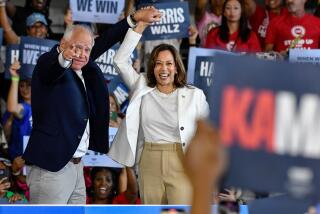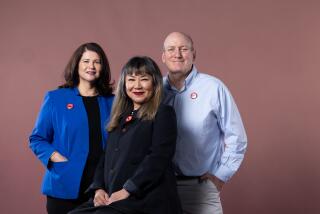UAW Leader Fueled by Concern for People : Union: For Ernie Lofton, who represents 97,000 workers at Ford Motor Co. and is active in civil rights, labor and social causes are linked.
- Share via
DETROIT — The first time Ernie Lofton appeared at the gate of Ford Motor Co.’s Dearborn, Mich., iron foundry looking for work, the lines were so long he was told to come back the next day.
Determined to land a well-paying job in the foundry--and in spite of work that was tough and grimy, to say nothing of dangerous--Lofton returned the next day and was hired.
That was in 1950. Forty-three years later, no one at Ford tells Lofton to come back tomorrow.
As vice president of the United Auto Workers, representing 97,000 hourly workers at the No. 2 auto maker, Lofton carries a lot of clout and also has the respect of Ford executives who are his adversaries.
“I’m glad that 40 years ago, he had the tenacity to go through what he went through,” doing the difficult and hazardous work at the foundry, said Peter Pestillo, Ford vice president of corporate relations and diversified business.
“How he could still be a loyal Ford guy after that, I don’t know, but I’m sure glad he is,” Pestillo said.
Don’t misunderstand--Lofton is no company shill. His allegiance is to the UAW, but he knows that getting a better contract for his membership this September is linked to how well the company paying for that contract is doing.
Among the Big Three, Ford is the healthiest financially. Not coincidentally, it has the best overall relations with the UAW.
The company and the union have disagreements “but not to the point (where) it has diminished our ability to look at what’s in the best interest of Ford and the UAW,” Lofton said.
Many credit Lofton’s low-key style and communication skills for sustaining a labor-management relationship born during Ford’s early ‘80s wave of plant closings and layoffs. Lofton, now 61, was on the UAW bargaining team in 1979 and 1982 and remembers well the pain of those days.
The UAW’s Ford department has just more than half the 180,000 members that were on its rolls in 1979. But the crisis years brought the company and union closer instead of pushing them apart. Novel education and retraining programs were created and promises of increased funding for them in better economic times were kept.
“Ford talked with the leadership and the membership and explained why they had to reduce the plants, because they had too much capacity, because their market share was dropping,” Lofton said. “I think, unlike General Motors, when you explain your facts to people, they might not relish hearing about them, but at least they can appreciate them and understand them.”
GM is far behind Ford in trying to build trust with the UAW. The No. 1 auto maker acknowledges that it botched its 1991 announcement that it would close 21 (now 23) plants and cut 74,000 jobs by mid-decade. The UAW was among the last to hear of the plans.
Such a mistake would be unlikely at Ford.
“The way the relationship has evolved at Ford, you have very frequent dealings with Ernie and his staff,” said Jack Hall, Ford’s vice president of employee relations. “When you have an understanding with Ernie, you have a great understanding.”
Lofton’s UAW leadership credentials began as recording secretary, bargaining committeeman and president of Ford’s Specialty Foundry Unit in Dearborn. That led to his election as second vice president and later first vice president of Local 600, which represents the Rouge complex in Dearborn.
Over the same time period, Lofton began working in the civil rights movement.
“I got involved back in the ‘50s,” he recalled. “You were talking about people who were evicted from homes . . . people who had no jobs . . . racism, bigotry--those kinds of things. And as I progressed upward in my union career, they sort of dovetailed.”
Lofton is first vice president of the Detroit chapter of the NAACP and has been for longer than Executive Director Joann Watson can recall. He’s also a national board member of the civil rights organization.
“The thing about Ernie Lofton is that he cares about people and I think it comes across,” said Jim McNeil, Local 600 president and the UAW’s negotiating chairman at Ford this summer.
Lofton was appointed to the staff of the UAW’s Region 1 in 1982 and elected regional director in 1983. Two terms as regional director led to his election as a vice president.
Lofton said the UAW is committed to having at least one black and one woman among its international vice presidents. He was preceded by Mark Stepp, the vice president in charge of the union’s Chrysler department.
A dearth of black and women leaders rising through the UAW’s local ranks is of grave concern to Lofton. Of 13 regional directors, the only black is Ruben Burks in Flint. No woman is a regional director, considered a requisite step toward higher office. Only one assistant regional director is black, although blacks make up 15% to 20% of UAW membership.
Lofton is all but certain to be reelected in 1995, and he said it is too soon to know who might succeed him upon his retirement in 1998. One possibility among many is Lofton’s administrative assistant, 48-year-old Gerald Bantom.






